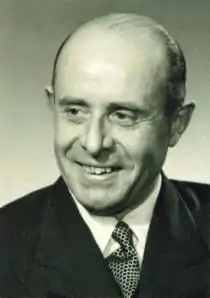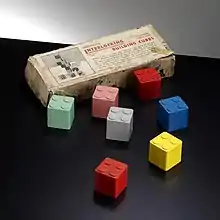Hilary Page
Hilary "Harry" Fisher Page (20 August 1904 – 24 June 1957) was an English toy maker and inventor of Self-Locking Building Bricks, the predecessor of Lego bricks. He founded the Kiddicraft toy company.
Hilary Page | |
|---|---|
 | |
| Born | Hilary Fisher Page 20 August 1904 Sanderstead, England |
| Died | 24 June 1957 (aged 52) |
| Other names | Harry |
| Occupation | Toy maker |
| Known for | Inventing Self-Locking Building Bricks |
Early life
Hilary "Harry" Fisher Page was born on 20 August 1904 in Sanderstead, England. He was the first child of Samuel Fisher and Lillian Maude Page. As a child he made his own wooden toys and invented games supported by his father who worked in the lumber trade.[1]
Page was educated at Shrewsbury School from 1918 to 1923, where he began to display his entrepreneurial skills. Interested in photography, he set up a business developing photos for the other students. After his formal education he worked in the timber trade, like his father, for several years and in 1929 married Norah Harris, a long-time friend of the family. The couple's only daughter was born in 1932.[2][3] Together with his second wife Oreline he adopted twin girls in 1946.[3]
Kiddicraft

.jpg.webp)
Page, along with several partners, decided to go into the toy business in 1932. The partners opened a small toy shop called Kiddicraft on Godstone Road in Purley, Surrey. Originally, Page imported wooden toys from Russia, but later began to introduce his own designs.[4] Page had become increasingly unhappy using wood as a material for children's toys and was an early advocate of plastics as a safe and hygienic alternative.[5] In 1936, he began manufacturing Kiddicraft ‘Sensible’ toys using new injection moulding technology and in 1937 these were sold under the Bri-Plax brand forming a new company, British Plastic Toys Ltd. Among them was an Interlocking Building Cube, for which he received a British patent in 1940.[6][7][8]
The Self-Locking Building Brick
Post WWII, Page designed and produced the Kiddicraft Self-Locking Building Bricks,[9] that have been described as the "original LEGO".[10] These were smaller, refined versions of the Interlocking Building Cube. Bricks could be stacked on each other and were held in place by studs on the top. The bricks also featured slits on their side that allowed panel-like doors, windows or cards to be inserted. He patented the basic design, a 2 × 4 studded brick, in 1947. This was later followed by patents for the side slits (1949) and the baseplate (1952), designs featured in exhibits at the Brighton Toy and Model Museum.[11]
The Kiddicraft Self-Locking Building Brick sets were first marketed in 1947. As a promotion Page and his family built large display models for the 1947 Earl's Court Toy Fair.[12] The Victoria and Albert Museum of Childhood in London lists the bricks among the "must-have toys" of the 1940s.[13]
LEGO's copy
Ole Kirk Christiansen and his son Godtfred became aware of the Kiddicraft brick after examining a sample, and possibly drawings, given to them by the British supplier of the first injection moulding machine they had purchased. Realising their potential, Ole modified the Kiddicraft brick and in 1949 marketed his own version, The Automatic Binding Brick, that became the Lego brick in 1953.[14][15]
Page was reportedly never aware of this according to his family, and the company Lego Ole Christiansen founded expanded into Western Europe. British Lego Ltd. was set up in late 1959 and the first sets were sold the following year. Lego eventually acquired the residual rights to the Kiddicraft brick designs in 1981. In an out-of-court settlement, Lego paid UK £45,000 to the new owners of Page's company Hestair-Kiddicraft.[16]
LEGO acknowledges Kiddicraft as the origin of their bricks on their history website, and tells a different version of how things happened. They say that they contacted Kiddicraft in the late 1950s to ask them if they would object to the LEGO brick, and that Kiddicraft did not.[17]
Publications
After founding Kiddicraft, Page spent several years studying early childhood play. He conducted research by spending time playing with children in various nursery schools to find out their interests. This research culminated in 1938 in the publication of his book titled Playtime in the First Five Years.[18]
Death
Troubled by pressures on the business and fearing a collapse of his company, Page died by suicide on 24 June 1957.[19] In 1987, his widow stated, "He died before Lego brought out the product in Britain. He didn't know about it."[20]
Posthumous recognition
Page was recognised as an innovator in child education and toy design in 2007 with a Lifetime Achievement Award from the British Toy and Hobby Association.[21]
References
- "Hilary Fisher Page and Kiddicraft". OrnaVerum. Retrieved 22 May 2020.
- "KIDDIKRAFT". Miniland Online. Retrieved 11 October 2018.
- Jim Hughes, Chas Saunter: Hilary Fisher Page & Kiddicraft (2008). In: hilarypagetoys.com, access date 14 July 2020.
- "Hilary Page and Kiddicraft". The Plastics Historical Society. Retrieved 11 October 2018.
- Page, Hilary Fisher. Playtime in the First Five Years. Second edition. London: Allen & Unwin, 1953.
- Page, Hilary. “Improvements in Toy Building Blocks” UK patent 529,580. 17 Apr 1940.
- Michael M. Patte and John A. Sutterby (eds.) Celebrating 40 Years of Play Research: Connecting Our Past, Present, and Future, Volume 13, Hamilton Books UK 2016
- Rodney P. Carlisle (ed.) Encyclopedia of Play in Today's Society, Volume 1, SAGE Publications 2009
- Maaike Lauwaert, Playing outside the box – on LEGO toys and the changing world of construction play, History and Technology, Volume 24, 221-237, 2008 doi:10.1080/07341510801900300
- Mimoso, João (12 February 2010). "Kiddicraft, LEGO before LEGO". www.inverso.pt. Retrieved 11 October 2018.
- BTMM Eric. "Self-Locking Building Bricks, Set No.1 (Kiddicraft) - The Brighton Toy and Model Index". The Brighton Toy and Model Index. Brighton Toy and Model Museum. Retrieved 11 October 2018.
- Page‘s twin daughters play with a set of Kiddicraft K 263 Building Blocks "Twins and Skyscrapers". brickfetish.com. Retrieved 11 October 2018.
- "Must Have Toys 1940s - V&A Museum of Childhood". V&A Museum of Childhood. Victoria and Albert Museum, London. Retrieved 11 October 2018.
- Christiansen, Godtfred. "Improvements Relating to Toy Building Sets" UK patent GB 866557. 26 Apr 1961
- Walsh, Tim, Timeless Toys: Classic Toys and the Playmakers Who Created Them, Andrews McMeel Publishing, 2005
- Glancey, Jonathan (28 July 2008). "Jonathan Glancey: Lego is a toy of gentle genius". The Guardian. Retrieved 11 October 2018.
- "Automatic Binding Bricks". LEGO® History. Retrieved 7 April 2021.
- "Week 33: Playtime in the First Five Years". Robert Menzies Institute. Retrieved 7 October 2022.
- "History - Hilary Page Toys". www.hilarypagetoys.com. Retrieved 28 January 2019.
- Chung, Frank (12 July 2018). "Absolute rip-off: The billion-dollar empires built on lies". NZ Herald. Retrieved 6 October 2022.
- Lee Davies (21 February 2015). "Hilary Page Lifetime Achievement Award" – via YouTube.